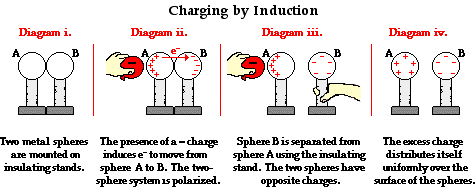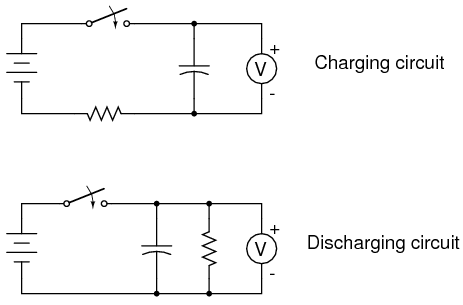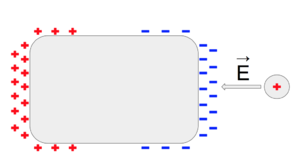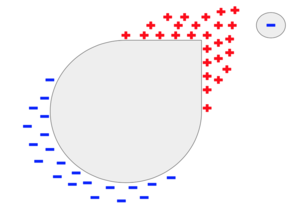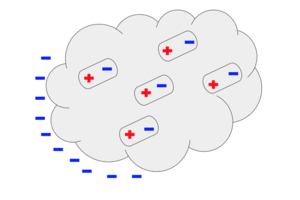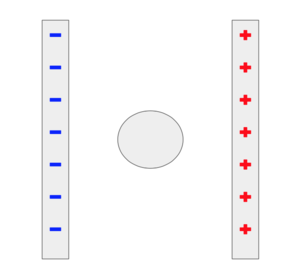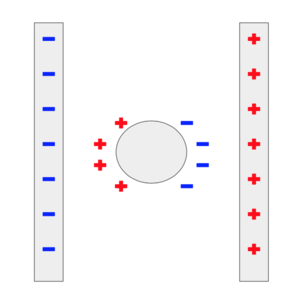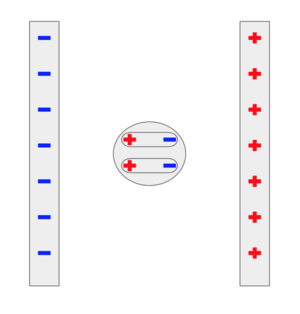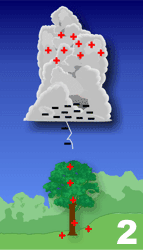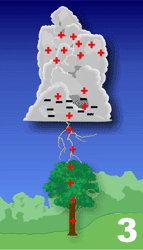Charged Conductor and Charged Insulator: Difference between revisions
No edit summary |
|||
| (42 intermediate revisions by 3 users not shown) | |||
| Line 1: | Line 1: | ||
Claimed by Amanda Barber Spring 2018 | |||
Okay – so we know that '''charged particles''' exist out there (shout out to those positrons and electrons for being “lit” when they annihilate) and that objects can either be negatively charged, positively charged, or neutral depending on the ratio of charged particles that object has. For example, if I happen to observe some random thing in nature that has 5 protons and 4 electrons – that thing has a net charge of +1. But what we haven’t really explored '''''how something''''' (like a '''conductor''' or an '''insulator''') '''''becomes positively, negatively, or neutrally charged''''' or '''''what happens when something becomes charged'''''. Guess what? That’s what this wiki is about! And by the time you’ve finished reading this, you should have a better understanding of how one can become “charged up” (in the context of E&M physics, not in the context of 6 Gawd Drizzy Drake preparing to release the hottest diss track of the decade in response to “twitter-finger” beef initiated by former rapper Meek Mill in the Summer of 2015). | Okay – so we know that '''charged particles''' exist out there (shout out to those positrons and electrons for being “lit” when they annihilate) and that objects can either be negatively charged, positively charged, or neutral depending on the ratio of charged particles that object has. For example, if I happen to observe some random thing in nature that has 5 protons and 4 electrons – that thing has a net charge of +1. But what we haven’t really explored '''''how something''''' (like a '''conductor''' or an '''insulator''') '''''becomes positively, negatively, or neutrally charged''''' or '''''what happens when something becomes charged'''''. Guess what? That’s what this wiki is about! And by the time you’ve finished reading this, you should have a better understanding of how one can become “charged up” (in the context of E&M physics, not in the context of 6 Gawd Drizzy Drake preparing to release the hottest diss track of the decade in response to “twitter-finger” beef initiated by former rapper Meek Mill in the Summer of 2015). | ||
| Line 7: | Line 5: | ||
==The Main Idea== | ==The Main Idea== | ||
Okay so remember in that short description above when I bolded and italicized the phrase “how something can become positively, negatively, or neutrally charged”? | Okay, so remember in that short description above when I bolded and italicized the phrase “how something can become positively, negatively, or neutrally charged”? The processes by which this can occur are called '''charging''' and '''discharging'''. The definitions are simple: charging – how an object becomes positively or negatively charged; discharging – how a positively or negatively charged object becomes neutral. What happens to an object as a result of charging or discharging depends on the nature of that object and whether or not the object is a conductor or an insulator. All materials are made of atoms that contain positive and negative charges (protons and electrons). While all materials contain these two basic units, the charge distribution patterns change depending on the microscopic behavior of the atom's movement in an electric field. These differences have created two distinct classes of materials: conductors and insulators. This article will explore the differences between a charged conductor and a charged insulator. But before we go further into the specifics regarding conductors and insulators, let us further discuss the means by which charging can occur: '''conduction''' and '''induction'''. Both processes involve objects becoming charged by exchanging, gaining, or losing mobile charged particles. In most examples, objects will become charged by gaining or losing electrons, but that is not always the case – other mobile charged particles can contribute to an objects net charge, such as mobile potassium or sodium ions. | ||
'''Charging by Conduction''' | |||
Okay, so y’all remember that example in lecture where the professor kept pulling tape apart? And the lab that followed up afterwards? That’s what charging by induction is all about! (No worries if you don’t remember or if you haven’t gotten to that part of the course yet – I’m not gonna leave you hanging and just assume you know and/or remember what that was all about. I gotcha back homie! Checkout this link: https://www.youtube.com/watch?v=O7siDnbEuko | Okay, so y’all remember that example in lecture where the professor kept pulling tape apart? And the lab that followed up afterwards? That’s what charging by induction is all about! (No worries if you don’t remember or if you haven’t gotten to that part of the course yet – I’m not gonna leave you hanging and just assume you know and/or remember what that was all about. I gotcha back homie! Checkout this link: https://www.youtube.com/watch?v=O7siDnbEuko | ||
As illustrated in the pulling tape exercise, charging by conduction is all about '''making contact in order to transfer charged particles'''. When the two strips of tape are quickly ripped apart, mobile charged particles ( | [[File:Charging tape.png|thumb|Charges on strips of tape as they are pulled apart from http://p3server.pa.msu.edu/coursewiki/doku.php?id=184_notes:charging_discharging]] | ||
As illustrated in the pulling tape exercise, charging by conduction is all about '''making contact in order to transfer charged particles'''. When the two strips of tape are quickly ripped apart, mobile charged particles (electrons) are transferred from one strip of tape to the other – leaving one strip positively charged and the other strip negatively charged. What mobile charged particles are transferred (such as electrons) and where those mobile charged particles go depends on chemical makeup of the materials involved in the process of charging by conduction. For example, when one is charging by conduction with plastic and wool – the plastic gains electrons to become negatively charged. But when one is charging by conduction using plastic and silk, the plastic loses electrons to become positively charged. | |||
'''Charging by Induction''' | |||
Charging by induction is all about '''using a charged object to separate mobile charged particles between two other neutral objects in contact with one another'''. First, the two neutral objects are in physical contact with each other outside the presence of the charged object. Next, the two objects are subject to the presence of a charged object, causing mobile charged particles to separate among the two connected objects, resulting in excess charge building up on the opposing surfaces of the two connected objects. Then, the two connected objects are separated while still subject to the presence of the charged object. Finally, the separated objects removed from the presence of the charged object and the excess charges distribute across the entire surfaces of each object, resulting in what were initially two neutral objects now being charged. | |||
Charging | [[File:Charging induction.png|thumb|Charging two neutral conductors by induction from http://p3server.pa.msu.edu/coursewiki/doku.php?id=184_notes:charging_discharging]] | ||
= | Here's a video that might also help explain charging by induction: https://www.youtube.com/watch?v=cMM6hZiWnig | ||
[[File:Inductiontransfer.gif]] | |||
'''Discharging''' | |||
Discharging is the opposite of charging: the process by which charged objects lose their excess charge and become neutral. There are a number of ways in which charged objects can discharge. For example, charged tape can be discharged by water in the surrounding environment (over time) or by using your finger and touching the tape. When we touch charged tape, our bodies act as electrical grounds. An electrical ground is huge pool of charged particles that remains neutral when small amounts of charged particles are added or taken away | Discharging is the opposite of charging: the process by which charged objects lose their excess charge and become neutral. There are a number of ways in which charged objects can discharge. For example, charged tape can be discharged by water in the surrounding environment (over time) or by using your finger and touching the tape. When we touch charged tape, our bodies act as electrical grounds. An electrical ground is huge pool of charged particles that remains neutral when small amounts of charged particles are added or taken away | ||
[[File:05172.png]] | |||
'''Charging Insulators''' | |||
[[File:Insulator and conductor.png|thumb|Charging an insulator vs charging a conductor from http://p3server.pa.msu.edu/coursewiki/doku.php?id=184_notes:charging_discharging]] | |||
Insulators can only be charged by conduction. When an insulator is charged by conduction, the charged particles remain at the initial point of contact throughout time until the insulator is discharged. | Insulators can only be charged by conduction. When an insulator is charged by conduction, the charged particles remain at the initial point of contact throughout time until the insulator is discharged. | ||
When a charged object enters the immediate region of an insulator, the result is polarization of the atoms and molecules within the insulator as seen in the example | |||
When a charged object enters the immediate region of an insulator, the result is polarization of the atoms and molecules within the insulator as seen in the example to the right (only while in the presence of that charged object). Since insulators impede the movement of charged particles, two insulators cannot be charged by induction in the presence of a charged object. | |||
Here’s a neat little simulator to see how an insulator (a balloon) can become charged by conduction and see what happens afterwards: | Here’s a neat little simulator to see how an insulator (a balloon) can become charged by conduction and see what happens afterwards: | ||
https://phet.colorado.edu/en/simulation/balloons-and-static-electricity | https://phet.colorado.edu/en/simulation/balloons-and-static-electricity | ||
'''Charging Conductors''' | |||
When conductors are charged by conduction, the excess charges distribute evenly across the entire surface of the conductor over time since conductors enable charged particles to move freely. While the inside electric field remains zero. This all happens because of Coulomb's Law. It insists that charges lay as far away from each other as atom-ly (you get it? like human-ly) possible. If you charge a conductor, the conductor becomes charged with whatever type of charged was used. i.e. i charge a metal ball with a negative charge, thus the ball becomes negatively charged. | |||
Here's a fun thing. You ever heard of the Van de Graaff? That metal ball thing that shocks you? It is an electrostatic generator that uses a belt of sorts to accumulate charge. It creates very big electric potentials so as you go to touch it, it discharges onto you, shocking you. | |||
Remember how I kept using the word “object” when describing the neutral things needed in explaining charging by induction? Yea, so those objects are always going to be conductors. So charging by induction is always charging conductors by induction. | Remember how I kept using the word “object” when describing the neutral things needed in explaining charging by induction? Yea, so those objects are always going to be conductors. So charging by induction is always charging conductors by induction. | ||
[[File:Inschargedist.gif|center|375]] | |||
===A Mathematical Model=== | |||
===A Computational Model=== | |||
==Examples== | ==Examples== | ||
[[File:Screen Shot 2018-04-08 at 4.16.06 PM.png|300 px]] | |||
[[File:Screen Shot 2018-04-08 at 4.27.27 PM.png|300 px]] | |||
[[File:Screen Shot 2018-04-08 at 4.34.27 PM.png|300 px]] | |||
===Example Problem=== | |||
A neutral metal sphere enters a capacitor, as shown. Show the charge distribution on the sphere. If the sphere was instead made of plastic, show the the charge distribution. | |||
A | |||
[[File: | [[File:Screen Shot 2018-04-08 at 4.37.07 PM.png|300 px]] | ||
== | ===Solution=== | ||
For a metal sphere: | |||
[[File: | [[File:Screen Shot 2018-04-08 at 4.38.17 PM.png|300 px]] | ||
Since metals are conductors, there are mobile electrons within the sphere that are free to move about the sphere when they feel the electrostatic force from the capacitor. | |||
For a plastic sphere: | |||
[[File:Screen Shot 2018-04-08 at 4.39.59 PM.png|300 px]] | |||
[[File: | |||
Plastic is an insulator, so the individual molecules will become polarized due to the capacitor and become dipoles. | |||
==Connectedness== | ==Connectedness== | ||
[[File:Lightning bedning.png|thumb|Mako bending lightning to save Republic City in Avatar Legend of Korra]] | |||
Okay, so I’m going to get super fan boy nerdy for a second and connect what we’ve learned about charging and discharging to my favorite cartoon of all time: Avatar The Last Airbender. For those of you not familiar with this amazing series – these resources might be help create some context (I highly recommend watching the original series and the spinoff with Avatar Korra): http://www.nick.com/avatar-the-last-airbender/ | Okay, so I’m going to get super fan boy nerdy for a second and connect what we’ve learned about charging and discharging to my favorite cartoon of all time: Avatar The Last Airbender. For those of you not familiar with this amazing series – these resources might be help create some context (I highly recommend watching the original series and the spinoff with Avatar Korra): http://www.nick.com/avatar-the-last-airbender/ | ||
| Line 71: | Line 90: | ||
Within the world of Avatar and bending, each bending art has one or more specialized bending techniques that are considered to be very rare, highly coveted skills. Lightening bending (or lightning generation) is a special technique within the art of firebending. Lightning bending is an extremely difficult technique to master, as it requires the bender to be at total peace and void of all emotion (which is why it was always impossible for Zuko to learn from Uncle Iroh because that boy had so many emotional issues – which is completely understandable considering his circumstances). | Within the world of Avatar and bending, each bending art has one or more specialized bending techniques that are considered to be very rare, highly coveted skills. Lightening bending (or lightning generation) is a special technique within the art of firebending. Lightning bending is an extremely difficult technique to master, as it requires the bender to be at total peace and void of all emotion (which is why it was always impossible for Zuko to learn from Uncle Iroh because that boy had so many emotional issues – which is completely understandable considering his circumstances). | ||
Lightning bending connects to charging and discharging in a few ways. Lightning (and lightning generation) in and of itself alone is a representation of electrical discharge. Lightning is created when two dense pools of opposite charges reach out and connect to one another, creating a channel for electrical transfer of charge that results in each pool becoming neutral once that transfer is complete. Before we continue, please watch the following video: https://www.youtube.com/watch?v=6htOzNpBJv8 | Lightning bending connects to charging and discharging in a few ways. Lightning (and lightning generation) in and of itself alone is a representation of electrical discharge. Lightning is created when two dense pools of opposite charges reach out and connect to one another, creating a channel for electrical transfer of charge that results in each pool becoming neutral once that transfer is complete. | ||
[[File:Strike1.gif]] [[File:Strike2.gif]] [[File:Strike3.gif]] | |||
Photos from free U.S. government resource: http://www.srh.noaa.gov/jetstream/lightning/lightning.html | |||
Before we continue, please watch the following video to see lightning bending in action: https://www.youtube.com/watch?v=6htOzNpBJv8 | |||
So let’s break down what we see in the video and how it relates to the physics of charging and discharging. Before we even see Uncle Iroh generate visible lightning, he “charges himself” by, “separating the energies of yin and yang” (according to Avatar mythology). In other words, Uncle Iroh separates mobile negatively charged particles (yin) from mobile positively charged particles (yang) within his body and immediate surroundings to set the stage for electrical charge transfer. When the amount of charge Uncle Iroh has built up in each pool is great enough to overcome the air and his body’s insulation of electric flow, this is the moment we begin to actually see lightning. The generated pools of charge connect and create a channel where charges begin to flow between pools in order for each pool to discharge and become neutral. | So let’s break down what we see in the video and how it relates to the physics of charging and discharging. Before we even see Uncle Iroh generate visible lightning, he “charges himself” by, “separating the energies of yin and yang” (according to Avatar mythology). In other words, Uncle Iroh separates mobile negatively charged particles (yin) from mobile positively charged particles (yang) within his body and immediate surroundings to set the stage for electrical charge transfer. When the amount of charge Uncle Iroh has built up in each pool is great enough to overcome the air and his body’s insulation of electric flow, this is the moment we begin to actually see lightning. The generated pools of charge connect and create a channel where charges begin to flow between pools in order for each pool to discharge and become neutral. | ||
| Line 80: | Line 105: | ||
While insulators are not useful for transferring charge, they do serve a critical role in electrostatic experiments and demonstrations. Conductive objects are often mounted upon insulating objects. This arrangement of a conductor on top of an insulator prevents charge from being transferred from the conductive object to its surroundings. | While insulators are not useful for transferring charge, they do serve a critical role in electrostatic experiments and demonstrations. Conductive objects are often mounted upon insulating objects. This arrangement of a conductor on top of an insulator prevents charge from being transferred from the conductive object to its surroundings. | ||
==History== | |||
(should be completed by a student) | |||
==See also== | ==See also== | ||
===Further Reading=== | |||
*[http://www.physicsbook.gatech.edu/Charge_Transfer Charge Transfer] | *[http://www.physicsbook.gatech.edu/Charge_Transfer Charge Transfer] | ||
*[http://www.physicsbook.gatech.edu/Insulators Insulators] | *[http://www.physicsbook.gatech.edu/Insulators Insulators] | ||
| Line 88: | Line 118: | ||
===External links=== | ===External links=== | ||
[http://www.schoolphysics.co.uk/age16-19/Electricity%20and%20magnetism/Electrostatics/text/Electric_charge_distribution/index.html Explanation of why charge concentrates at a point on a conductor] | *[http://www.schoolphysics.co.uk/age16-19/Electricity%20and%20magnetism/Electrostatics/text/Electric_charge_distribution/index.html Explanation of why charge concentrates at a point on a conductor] | ||
==References== | ==References== | ||
[http://www.physicsclassroom.com/class/estatics/Lesson-1/Conductors-and-Insulators http://www.physicsclassroom.com/class/estatics/Lesson-1/Conductors-and-Insulators] | *[http://www.physicsclassroom.com/class/estatics/Lesson-1/Conductors-and-Insulators http://www.physicsclassroom.com/class/estatics/Lesson-1/Conductors-and-Insulators] | ||
*http://www.schoolphysics.co.uk/age16-19/Electricity%20and%20magnetism/Electrostatics/text/Electric_charge_distribution/index.html | |||
*http://p3server.pa.msu.edu/coursewiki/doku.php?id=184_notes:charging_discharging | |||
*http://avatar.wikia.com/wiki/Specialized_bending_techniques | |||
*http://www.srh.noaa.gov/jetstream/lightning/lightning.html | |||
Latest revision as of 13:49, 11 May 2020
Claimed by Amanda Barber Spring 2018
Okay – so we know that charged particles exist out there (shout out to those positrons and electrons for being “lit” when they annihilate) and that objects can either be negatively charged, positively charged, or neutral depending on the ratio of charged particles that object has. For example, if I happen to observe some random thing in nature that has 5 protons and 4 electrons – that thing has a net charge of +1. But what we haven’t really explored how something (like a conductor or an insulator) becomes positively, negatively, or neutrally charged or what happens when something becomes charged. Guess what? That’s what this wiki is about! And by the time you’ve finished reading this, you should have a better understanding of how one can become “charged up” (in the context of E&M physics, not in the context of 6 Gawd Drizzy Drake preparing to release the hottest diss track of the decade in response to “twitter-finger” beef initiated by former rapper Meek Mill in the Summer of 2015).
The Main Idea
Okay, so remember in that short description above when I bolded and italicized the phrase “how something can become positively, negatively, or neutrally charged”? The processes by which this can occur are called charging and discharging. The definitions are simple: charging – how an object becomes positively or negatively charged; discharging – how a positively or negatively charged object becomes neutral. What happens to an object as a result of charging or discharging depends on the nature of that object and whether or not the object is a conductor or an insulator. All materials are made of atoms that contain positive and negative charges (protons and electrons). While all materials contain these two basic units, the charge distribution patterns change depending on the microscopic behavior of the atom's movement in an electric field. These differences have created two distinct classes of materials: conductors and insulators. This article will explore the differences between a charged conductor and a charged insulator. But before we go further into the specifics regarding conductors and insulators, let us further discuss the means by which charging can occur: conduction and induction. Both processes involve objects becoming charged by exchanging, gaining, or losing mobile charged particles. In most examples, objects will become charged by gaining or losing electrons, but that is not always the case – other mobile charged particles can contribute to an objects net charge, such as mobile potassium or sodium ions.
Charging by Conduction
Okay, so y’all remember that example in lecture where the professor kept pulling tape apart? And the lab that followed up afterwards? That’s what charging by induction is all about! (No worries if you don’t remember or if you haven’t gotten to that part of the course yet – I’m not gonna leave you hanging and just assume you know and/or remember what that was all about. I gotcha back homie! Checkout this link: https://www.youtube.com/watch?v=O7siDnbEuko
As illustrated in the pulling tape exercise, charging by conduction is all about making contact in order to transfer charged particles. When the two strips of tape are quickly ripped apart, mobile charged particles (electrons) are transferred from one strip of tape to the other – leaving one strip positively charged and the other strip negatively charged. What mobile charged particles are transferred (such as electrons) and where those mobile charged particles go depends on chemical makeup of the materials involved in the process of charging by conduction. For example, when one is charging by conduction with plastic and wool – the plastic gains electrons to become negatively charged. But when one is charging by conduction using plastic and silk, the plastic loses electrons to become positively charged.
Charging by Induction
Charging by induction is all about using a charged object to separate mobile charged particles between two other neutral objects in contact with one another. First, the two neutral objects are in physical contact with each other outside the presence of the charged object. Next, the two objects are subject to the presence of a charged object, causing mobile charged particles to separate among the two connected objects, resulting in excess charge building up on the opposing surfaces of the two connected objects. Then, the two connected objects are separated while still subject to the presence of the charged object. Finally, the separated objects removed from the presence of the charged object and the excess charges distribute across the entire surfaces of each object, resulting in what were initially two neutral objects now being charged.
Here's a video that might also help explain charging by induction: https://www.youtube.com/watch?v=cMM6hZiWnig
Discharging
Discharging is the opposite of charging: the process by which charged objects lose their excess charge and become neutral. There are a number of ways in which charged objects can discharge. For example, charged tape can be discharged by water in the surrounding environment (over time) or by using your finger and touching the tape. When we touch charged tape, our bodies act as electrical grounds. An electrical ground is huge pool of charged particles that remains neutral when small amounts of charged particles are added or taken away
Charging Insulators
Insulators can only be charged by conduction. When an insulator is charged by conduction, the charged particles remain at the initial point of contact throughout time until the insulator is discharged.
When a charged object enters the immediate region of an insulator, the result is polarization of the atoms and molecules within the insulator as seen in the example to the right (only while in the presence of that charged object). Since insulators impede the movement of charged particles, two insulators cannot be charged by induction in the presence of a charged object.
Here’s a neat little simulator to see how an insulator (a balloon) can become charged by conduction and see what happens afterwards: https://phet.colorado.edu/en/simulation/balloons-and-static-electricity
Charging Conductors
When conductors are charged by conduction, the excess charges distribute evenly across the entire surface of the conductor over time since conductors enable charged particles to move freely. While the inside electric field remains zero. This all happens because of Coulomb's Law. It insists that charges lay as far away from each other as atom-ly (you get it? like human-ly) possible. If you charge a conductor, the conductor becomes charged with whatever type of charged was used. i.e. i charge a metal ball with a negative charge, thus the ball becomes negatively charged.
Here's a fun thing. You ever heard of the Van de Graaff? That metal ball thing that shocks you? It is an electrostatic generator that uses a belt of sorts to accumulate charge. It creates very big electric potentials so as you go to touch it, it discharges onto you, shocking you.
Remember how I kept using the word “object” when describing the neutral things needed in explaining charging by induction? Yea, so those objects are always going to be conductors. So charging by induction is always charging conductors by induction.
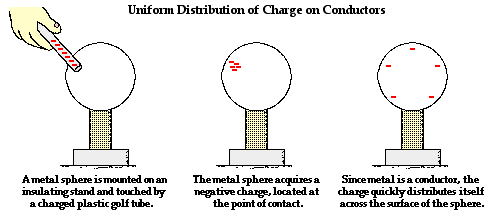
A Mathematical Model
A Computational Model
Examples
Example Problem
A neutral metal sphere enters a capacitor, as shown. Show the charge distribution on the sphere. If the sphere was instead made of plastic, show the the charge distribution.
Solution
For a metal sphere:
Since metals are conductors, there are mobile electrons within the sphere that are free to move about the sphere when they feel the electrostatic force from the capacitor.
For a plastic sphere:
Plastic is an insulator, so the individual molecules will become polarized due to the capacitor and become dipoles.
Connectedness
Okay, so I’m going to get super fan boy nerdy for a second and connect what we’ve learned about charging and discharging to my favorite cartoon of all time: Avatar The Last Airbender. For those of you not familiar with this amazing series – these resources might be help create some context (I highly recommend watching the original series and the spinoff with Avatar Korra): http://www.nick.com/avatar-the-last-airbender/
Within the world of Avatar and bending, each bending art has one or more specialized bending techniques that are considered to be very rare, highly coveted skills. Lightening bending (or lightning generation) is a special technique within the art of firebending. Lightning bending is an extremely difficult technique to master, as it requires the bender to be at total peace and void of all emotion (which is why it was always impossible for Zuko to learn from Uncle Iroh because that boy had so many emotional issues – which is completely understandable considering his circumstances).
Lightning bending connects to charging and discharging in a few ways. Lightning (and lightning generation) in and of itself alone is a representation of electrical discharge. Lightning is created when two dense pools of opposite charges reach out and connect to one another, creating a channel for electrical transfer of charge that results in each pool becoming neutral once that transfer is complete.
Photos from free U.S. government resource: http://www.srh.noaa.gov/jetstream/lightning/lightning.html
Before we continue, please watch the following video to see lightning bending in action: https://www.youtube.com/watch?v=6htOzNpBJv8
So let’s break down what we see in the video and how it relates to the physics of charging and discharging. Before we even see Uncle Iroh generate visible lightning, he “charges himself” by, “separating the energies of yin and yang” (according to Avatar mythology). In other words, Uncle Iroh separates mobile negatively charged particles (yin) from mobile positively charged particles (yang) within his body and immediate surroundings to set the stage for electrical charge transfer. When the amount of charge Uncle Iroh has built up in each pool is great enough to overcome the air and his body’s insulation of electric flow, this is the moment we begin to actually see lightning. The generated pools of charge connect and create a channel where charges begin to flow between pools in order for each pool to discharge and become neutral.
So all in all, in order for a firebender to lighting bend, the bender must be adept at charging and discharging to perform the technique. Once the lighting is generated, the bender then guides the discharging electric flow of energy in a desired direction (more than likely at an opponent in order to zap them).
Note: all representations of anything related to Avatar The Last Airbender are property of Nickelodeon and they rights are reserved.
While insulators are not useful for transferring charge, they do serve a critical role in electrostatic experiments and demonstrations. Conductive objects are often mounted upon insulating objects. This arrangement of a conductor on top of an insulator prevents charge from being transferred from the conductive object to its surroundings.
History
(should be completed by a student)
See also
Further Reading
External links
References
- http://www.physicsclassroom.com/class/estatics/Lesson-1/Conductors-and-Insulators
- http://www.schoolphysics.co.uk/age16-19/Electricity%20and%20magnetism/Electrostatics/text/Electric_charge_distribution/index.html
- http://p3server.pa.msu.edu/coursewiki/doku.php?id=184_notes:charging_discharging
- http://avatar.wikia.com/wiki/Specialized_bending_techniques
- http://www.srh.noaa.gov/jetstream/lightning/lightning.html
